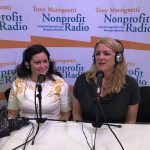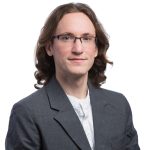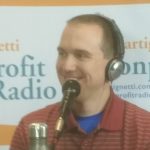
My Guest:
Amy Sample Ward: Center Equity & Tech In Your Hiring, Retention & Training

Amy Sample Ward returns for a valuable, fun conversation that starts with the #ShowTheSalary campaign and winds into technology strategies for treating your staff like adults and learners. She’s our technology and social media contributor, and CEO of NTEN.
Listen to the podcast
Podcast: Play in new window | Download
Get Nonprofit Radio insider alerts!
I love our sponsors!
![]() Turn Two Communications: PR and content for nonprofits. Your story is our mission.
Turn Two Communications: PR and content for nonprofits. Your story is our mission.
Sendinblue: The only all-in-one digital marketing platform empowering nonprofits to grow.
We’re the #1 Podcast for Nonprofits, With 13,000+ Weekly Listeners
Board relations. Fundraising. Volunteer management. Prospect research. Legal compliance. Accounting. Finance. Investments. Donor relations. Public relations. Marketing. Technology. Social media.
Every nonprofit struggles with these issues. Big nonprofits hire experts. The other 95% listen to Tony Martignetti Nonprofit Radio. Trusted experts and leading thinkers join me each week to tackle the tough issues. If you have big dreams but a small budget, you have a home at Tony Martignetti Nonprofit Radio.
View Full Transcript
Processed on: 2021-06-29T12:48:45.958Z
S3 bucket containing transcription results: transcript.results
Link to bucket: s3.console.aws.amazon.com/s3/buckets/transcript.results
Path to JSON: 2021…06…547_tony_martignetti_nonprofit_radio_20210628.mp3.449627571.json
Path to text: transcripts/2021/06/547_tony_martignetti_nonprofit_radio_20210628.txt
Hello and welcome to Tony-Martignetti non profit radio big non profit ideas for the other 95%. I’m your aptly named host of your favorite abdominal podcast. Oh, I’m glad you’re with me. I’d be forced to endure the pain of para Nicaea if you infected me with the idea that you missed this week’s show center equity and tech in your hiring retention and training. Amy sample Ward returns for a valuable fund conversation that starts with the show the salary campaign and winds into technology strategies for treating your staff like adults and learners. She’s our technology and social media contributor and ceo of N 10 on tony state too. Let’s rejoice, we’re sponsored by turn to communications pr and content for nonprofits. Your story is their mission turn hyphen two dot C o. And by sending blue the only all in one digital marketing platform empowering non profits to grow. tony-dot-M.A.-slash-Pursuant in blue, let’s get started, shall we, what do you say here is center equity and tech in your hiring retention and training. It’s always a pleasure to welcome back Amy sample ward. You know her, you know who she is, she’s our technology and social media contributor and she’s the Ceo of N 10. Her most recent co authored book is social change anytime everywhere about online multi channel engagement. She’s at a me sample ward dot org and at AMy R. S Ward, Welcome back amy, [00:02:05.44] spk_0:
it’s been so long. [00:02:15.34] spk_1:
I know it’s been several months. I didn’t even look back. It’s been too long, but let’s not, let’s not dwell on that. We’ll get, it’s my job to fix it. [00:02:16.81] spk_0:
So what is time anyway? You [00:02:19.37] spk_1:
know? Oh, that’s an existential question that we don’t have the time to answer what time is. So, um, you’re well in Oregon. Yes. [00:03:00.44] spk_0:
Yeah. Doing pretty well hot. We’re hot in Oregon. We’ve got, we’ve got a hot hot keep wave and a hot summer ahead of us, but otherwise doing okay. And you know, I think like a lot of parts of the country, the kind of atmosphere feels like it’s lifting a little bit as, as cities kind of open up more because because it is summer, even if it’s super hot, it’s better to be outside and see other people, You know, I think after a long hard winter, people really just be inside [00:03:08.12] spk_1:
Last summer, largely the same. Yeah, at least if you were doing the right thing. So yes, it beats the hell out of summer, 2020, [00:03:15.10] spk_0:
right? Yeah. [00:03:17.44] spk_1:
Although I’m sorry that climate change has contributed to bad temperatures in Oregon and [00:03:22.55] spk_0:
yeah, yeah, we’ve already, it’s already fire season here and fire [00:03:27.78] spk_1:
season is all the year now. Now California just doesn’t even have a fire season anymore. They just have fire fire [00:04:40.64] spk_0:
thinking about, you know, how many And and 10 has community members all over the us Canada Europe all around the world. Um, and so it’s something we’re always thinking about is, you know, what’s going on and for somebody that might open an email or show up to a court. So being one of our cohort programs where we’re really kind of expecting a lot of you over an extended period of time and, you know, there’s folks in so many different geography, so many different identities, so many different kind of compounding factors where it just might not be a day that you can join of course, you know, and we have done a lot of work, kind of, all of all of 2020 started in 2019 and launched this calendar year with a number of changes to our programs so that people were better able to say, yeah, this isn’t the day that I can join us and that they weren’t kind of like slowly slipping behind or slipping out of any of our programs, that the system was already built for them to be like, yeah, not today. You know, uh again, [00:05:15.54] spk_1:
we’re gonna talk about that to me that falls under the rubric of tech equity. We’re gonna we’re gonna talk about that. Let’s start with the something I know is on your mind. The show the salary campaign. There was it was a critical piece In the chronicle of philanthropy. Just yesterday, we’re recording on June 23 yesterday. There was a piece by Vincent Robinson, critical of show the salary campaign. Let’s acquaint folks with what show the salary is [00:06:21.64] spk_0:
for sure. So I think show the salary like hashtag no spaces show the salary is a campaign, but it is not the only movement for there are many, many folks, many different hashtags, many different appeals to the sector at large, whether that’s foundation jobs or nonprofit jobs, whoever to include the salary, whether that’s a hard and fast number or that’s a range in every job hosting from Ceo to to any other position really because of the number of dynamics that come when you don’t show that salary and the privilege that it really wraps itself around, um that it’s not creating an equitable opportunity or access point for all different kinds of folks to apply for that job. And show the show salary is one of these campaigns and efforts to encourage folks whether by asking nicely or shaming whichever direction works to get people to do it [00:07:41.14] spk_1:
all right. And some of the some of the reasons that showing the salary is important are I know that it gives an advantage to folks who negotiate salary better, which is typically white men. They are more confident in their negotiations. They have better outcomes when they attempt to negotiate. If not even better outcomes, they at least get get a better reaction when they attempt to negotiate. So it gives advantage to the white privileged. Um It’s um it’s disadvantageous in that you might be, I mean this this applies to everybody. You you might spend your time applying for a job that’s beneath your salary requirement. We all got to cover. We all got to cover a monthly nut. And if your salary isn’t gonna do it, you gotta go through a a laborious process to find that out. Maybe a couple of interviews, several hours your research time, you’re spiffing up your resume time, your credentials. So why should I hide it from anybody? Um on the positive side, he promotes transparency and you’d like to hire people who want to work for transparent organizations and people want to work for transparent organization? What am what am I what am I leaving out of the why the advantages, the reasons for showing the salary? [00:08:32.14] spk_0:
I mean, I think all of those are right. And also all of those are kind of like doorways into an entire, you know, grouping of arguments that are related to them, right? And I think it intend we really um combined when we’re trying to mask or compelled or encourage or convince other organizations to include salaries to us that means compensation and generally make clear what your benefits really are. Don’t say generous benefits because to your point, if someone is um has chronic illness and they know that health care is going to be a really important part of the benefits they get and all that you’ve said is generous benefits. They don’t know how to navigate if that’s going to be worth their time competitive [00:08:54.34] spk_1:
Really. You know, when you think about these things critically, which, you know, it’s, it’s just uh you know, for me at 59 years old, it’s what I grew up with commensurate salary, salary commenced with the experience and generous benefits. No, but if you do think about that well, it really communicates nothing generous, generous by whose standards commensurate by what type of experience [00:08:57.34] spk_0:
and with the arbiter of that. Right? [00:08:59.53] spk_1:
Well who is it? Yeah, who is? Right. [00:10:24.74] spk_0:
Yeah. I think especially as uh folks are starting to maybe in a token izing way, look to increase the number of black indigenous staff of color, um, L G B T Q I plus like all different, you know, quote unquote diverse metrics for their staff. Those folks want to know that they are going to be evaluated by something they opted into, Right? So seeing something like, oh, it’s commensurate with experience. Well, if you are excited to hire me because I also speak spanish, but you’re not, you’re not giving me a salary because of that, then that’s probably not a great place, right? Like all of those decisions add up to a picture that’s getting painted to potential staff before they even apply, let alone are hired and start there. And if you think about, you know, what is this picture we’re painting? Is it just like murky and you can’t see anything isn’t really clear. We painted a beautiful picture of this land. They could come come join. You know, it isn’t just like what’s in the organization’s interest because you really want to be able to negotiate with someone. I would, I would invite a bit of reflection on why you want to change something, you know, because if you don’t already know how much you can pay, that’s how much you can pay. And if you don’t, then you’re probably not ready to start hiring. [00:11:23.84] spk_1:
Okay. Uh, Vincent Robinson pushed back against the show the salary campaign. His his main point is that now he is a recruiter. He makes a point of saying that his practice is devoted to expanding diversity and accessibility among job applicant among applicants. Yes. And placements that he makes uh, he says that 90% of the candidates that he places are diverse. Bye bye. Common standards. Alright, So let’s, let’s just assume that that’s all the case. Uh, take him at his word for that. He says that the main problem with the show, the salary campaign is that it actually disadvantages folks. Um what’s this point? Because [00:11:32.54] spk_0:
I mean, essentially, if I can, can recap it, um, the way that we read it and have discussed, invented is essentially saying that by disclosing that salary, so don’t already make it discouraged, right? Would feel that they wouldn’t go for that job. And [00:12:22.64] spk_1:
Their if their current as it uses the example of someone whose salary is $60,000 and they feel they’re eminently qualified for a job that posts range, or a salary of $150,000, that they will be discouraged from applying because they feel they’re not worthy of that salary. And he says that he has counseled many people in that situation that they should absolutely apply. What does the I’m not I don’t want to make you a spokesman for the show, the salary campaign. We don’t even know who the members of the show the salary campaign are, which we are going to talk about. The secretive side of that. I’m curious about that. We’ll get to that as an advocate for show the salary. What do you say to Mr Robinson? [00:15:23.34] spk_0:
Sure, I wouldn’t have nothing to do with the show, the salary campaign. And as far as I understand it, it’s a campaign started by nonprofit staff in the charity sector in the UK. Um wow, she and being in love with their julie and I have nothing to do with it. But there are, you know, folks like Julie and the community centric fundraising community and 10 lots of folks in the us have also been calling for this. I think the idea that someone would see a higher salary and think that they are not qualified. I’m not going to say that doesn’t exist like humans are complicated, dynamic, interesting creatures. And I’m sure there are people for whom they have experienced a lifetime of internalized messages that they are not worthy of that job, right? That is not going to be changed by all organizations continuing to hide the salary. We’re not changing the sectors general attitude that everyone deserves more money by hiding salary. So even if, even if there are individual use cases where people were discouraged because of a high salary, that is not a validation for not disclosing it. And ultimately, by showing those salaries, you’re encouraging peer organizations to equally pay that much for the similar title or scoped positions. Um, You know, I think another perspective, we talked about an intent was, well, if that person is making 60,000 there in an organization that has the full kind of, uh, equate herbal scope to that other position, then they probably shouldn’t be making 60. And the issue is that they are currently making too little, not that they are not qualified for a job that makes twice as much right. That the real issue is, is their current place of employment and that that place they should be able to use that job posting to say, hey, I like a race. I think the dynamic that’s not spoken about in the Chronicle piece that I do think is an important part of the conversation about hiring in the sector is the fact that that articles written by a recruit and I think that I have experienced and seen and coached many people applying for jobs who have a very different uh understanding or expectation or assumptions about what’s going on when they are dealing with a recruiter, then when they are applying directly to the organization. I think there’s a lot of messaging and marketing that recruitment firms are, you know, leadership or C. I. O. C Suite ceo type of jobs. And those feel like they imply a level of corporate nous, maybe certain size of organization, you know, and those are probably more likely the factors that are making folks feel like they don’t want to go for the job than the fact that it pays more money. But [00:15:43.84] spk_1:
it’s interesting just the existence of a recruiter could be off putting to a lot of folks who internalize messages about their credentials. [00:15:45.61] spk_0:
Not that I don’t think people should use recruiters, I definitely think they should, but I think that that’s an unspoken reality that is not factored into that article. [00:16:01.94] spk_1:
Right. Right. Right. Which I’m not sure that he would even acknowledge. Yeah. But okay, I [00:16:06.74] spk_0:
wanna, can I can I can I steer us back to the question and you always get to steer Can I give [00:16:10.01] spk_1:
you latitude [00:17:36.74] spk_0:
well, because you said something that I thought was interesting and we could talk about for a second earlier when you were saying, you know, expertise. Uh and I think that’s also a big part of all of this, is that If you were to take to job listings that you found, that said the salary and they said they were both $60,000 jobs, right? 60,000? Um as your annual salary? Mhm. I cannot imagine that you would find those two jobs, say they’re looking for the same experience or expertise or scope of job, even if they were both in communications are both in in programs, right? So I feel like there’s also an opportunity to be very open and intentional with how we phrase or or position to potential staff, what we were looking for when we hired you, because if it’s just like, you know how to use this database and you know, you know, you know how to do these tactical things, I don’t know how it matters who it is. You hire hire the first person then, right? Like if that’s the thing that’s most important to you, it’s just that they can technically do these things that feels to me like you maybe don’t even need a human. That’s a [00:17:51.64] spk_1:
pretty, that’s a pretty shallow job description. If it’s just a list of four things that you need to be able to do it, right, then you just hire the first person who can do those four things and it makes no difference who it is, [00:18:15.74] spk_0:
right? But I see, you know, intent as a dartboard and um see jobs posted in the sector on twitter et cetera all the time. I feel like hiring is kind of picking up now and I see so much of it is like we really want you to have experience with X database or X website platform or you know, and like does any of that matter? Can’t you teach somebody the [00:18:19.26] spk_1:
database? It’s all trainable, it’s all right, we need somebody who’s trainable [00:18:49.24] spk_0:
right? Like eager to learn, interested in doing the work that we do, but not that you already know how to do certain things right? That’s not the most compelling. And again back to that idea of like you’re painting a picture for these potential applicants, you’re painting a picture that like what they’re what they’re part of. That magical garden scene is like you have a hammer, you have a shovel, you have some seed like you know, it’s probably looks not as appealing, right? It looks like, oh yes, this is beautiful garden scene and I will sit over here hammering on the bench. [00:19:26.14] spk_1:
Uh I mean uh I guess what we’re, what we’re talking about though, depends on the level that you’re hiring too. I mean if if an expertise is required in something that’s not that’s not trainable, I mean you so you have I. T. Staff, you have the luxury of having write your own development team. Um [00:19:26.79] spk_0:
So yes, he does the work of a team. Okay. Okay. [00:19:32.40] spk_1:
Yes. We’ll shout him out now. Go ahead [00:19:34.25] spk_0:
dan. Yeah. [00:20:02.04] spk_1:
So you have the luxury of having a development person, web development person. Um So, you know, he has to have a basic level of skill or or beyond basic in certain things. I don’t know whether it’s C Plus plus or drooping or you know, whatever. I don’t know. Html Well, we’re beyond html That I know. So, you know, at that point you would, you would advertise a fluency with something, wouldn’t you? [00:20:09.44] spk_0:
Yeah. I mean when we hired for that position, you know, we certainly wanted to say these are the platforms we’re currently using. Um, but okay. And you need to, you [00:20:15.11] spk_1:
need to be able to support these. [00:20:58.64] spk_0:
Yeah. Yeah. But that was, you know, that’s more of like, hey, this is the job. So stop reading if you don’t know what wordpress is, Maybe not the posting for you, but the things that we really want our, that you, I want to be part of a team where every person has leadership responsibility. You know, you’re not just going to be told what to do. Like you also have to come up with what to do and uh, you know, we want everybody on the team helps with the Ntc. You’re going to like carry a sign down the hallway, put it somewhere. Like you don’t just get to sit at a computer. You know, like we really want to communicate that working at what working in china is like and make clear that that’s what we’re looking for, right vs. The list is for this salary. You can do these five technical things. [00:25:18.94] spk_1:
It’s time for a break. Turn to Communications, The Chronicle of philanthropy, the new york Times, Wall Street Journal, UsA Today stanford Social Innovation Review, the Washington post, The Hill Cranes, nonprofit Quarterly Forbes Market Watch. That’s where turned to clients have gotten recent exposure. You want that kind of press turn to has the relationships to make it happen. Turn hyphen two dot c O. Your story is their mission. It’s time for Tony’s take two. Let’s rejoice this summer. We’ve come so far from a year ago from where we were last summer. Let’s take some pleasure in this summer. I hope you can. Yes, there’s a long ways to go to My state. North Carolina is less than 50% vaccinated, but we’re so much further from where we were last summer. Let’s take some pleasure in how far we have come. I hope that you can do that in your own way. I hope you can schedule some time away or some just some time. It doesn’t even have to be time away. I hope you can schedule time for yourself, family, friends, all of which we couldn’t do couldn’t do safely a year ago. So let’s rejoice in how far we have come while at the same time recognizing there’s a good way to go before we’re out of the woods with this pandemic with the delta variant now and other possibilities of variations. Yeah, we’ve come a long way. I hope that you can take the time for yourself, for your family, for friends to do some rejoicing this summer. Have some fun, whatever form fun takes for you, whatever it is. If it’s crocheting, if it’s travel, if it’s stay home, okay if it’s more time with kids, nieces, nephews, grandchildren, whatever form fun takes for you. I hope you can do it. I hope you can because we are so much further along than we were this time last year. That is Tony’s take two sending blue. It’s an all in one digital marketing platform with tools to build end to end digital campaigns that look professional are affordable and keep you organized. They do digital campaign marketing. Most marketing software is designed for big companies and has that enterprise level price tag, tisk, tisk. It’s your life if you’re using one of those, send in blue is priced for nonprofits, easy to use marketing platform that walks you through the steps of building a campaign to try out, sending blue and get a free month. Hit the listener landing page at send in blue. We’ve got boo koo but loads more time for center equity and tech in your hiring retention and training. Very melodic. It’s like, it’s iambic pentameter. Almost. How do you encourage job posters on the N 10 job board, which I know is one of your more popular pages on the areas on the, on the site at n 10 dot org of course. Um, I know you require salary their number or arrange a minimum or arrange I guess. But beyond that, what, what can you or what can other folks do to either encourage it if they have a job board or working in their own job descriptions. [00:26:06.84] spk_0:
Yeah, it’s interesting. I think a lot of the other work that we do is not very publicly visible. I have had a number of community members over the years since we’ve been requiring salary where they want to post a position. They themselves had already asked their organization, what’s the salary going to be in the organizations that were not posting it? So then they come to me and say like, I don’t have a lot of positional power. But what I could do is like bring you in on a conversation that put some pressure on, you know, and have some conversation that, that does convince them because even if they didn’t want to do it, they’re doing it gradually. I was looking at them so they did it, you know, you know, [00:26:10.85] spk_1:
you know that, [00:26:11.79] spk_0:
well, you [00:26:13.28] spk_1:
Have the leverage of the N- 10 job board and we’re talking about technology if it detects job, the intent job board is like a Seminole place to be. [00:26:43.74] spk_0:
Right. Right. So I’ve had lots of places where I’ve either helped people come up with their talking points to take to their team or joined email threads or even had phone calls with hiring managers who weren’t convinced, you know, and just spent 10 minutes talking to them about it, um, to get them kind of to the other side. And I think that’s, You know, while it’s kind of maybe not in my job description, those 10 minute calls or helping somebody with their talking points in a Google dog are changing organizations. And I really love between that work, you know, [00:27:31.84] spk_1:
but that’s using intense influence the same way you do when you, uh, when you sign contracts for, for the NtC that you insist you have, you have certain requirements from, I guess diversity to food to, you know, whatever you use the leverage, use the leverage in that case it’s dollars in hiring case, it’s the N 10 job board you want to be on it. I mean the bottom line is you got to play by our rules. I’m happy to have a conversation with you about why those rules exist and how they contribute to the in 10 values, [00:27:33.92] spk_0:
How [00:27:43.54] spk_1:
they flow from the intent values. Maybe more more eloquent, but more appropriate. But in the end, you know, if you want to be on the job board, you gotta, you gotta use our rules if you want. You want the N 10 money, you want the N 10 conference at your center, then we have, we have certain basic requirements that are unyielding. [00:28:51.64] spk_0:
Yeah, it’s interesting because the intent job board, of course you can post a job, but I think most people think of when they think of a job board, like a part time or full time organization that you are working for overtime. But we also, you can also post gigs or RFP s shorter term project type posts and we require a salary or budget to be listed on those two and that’s actually the place where we get the most push back. Um and folks will say, well we don’t know what our budget is until people reply to our RFP. And while I understand that, could I feel like reality, there is just like a, just like a potential applicant to become an employee. A potential contractor also doesn’t know if this is a project that they should bother trying to take on if they have no idea what your budget. So again, you don’t know what your budget is. You’re not ready to hire. Call for our FPs. You [00:28:56.38] spk_1:
Need to know whether this is a $10,000 project or $60,000 project. I mean without saying a range of $10-$60,000, which is, which is worthless. People, people do that. Do they say? [00:29:08.44] spk_0:
Okay, sometimes? Yes. [00:29:10.03] spk_1:
Alright, well that’s [00:31:05.24] spk_0:
worth. Sometimes. Yes, we try and catch those and talk to people. But you know, I think that folks, it’s such, it’s also such a privileged position to say like, well, we don’t even know what the budget is, where what I hear in that is whatever people tell us is what we could pay. And I don’t think that most nonprofits have a relationship to their cash flow, where they could say whatever somebody says is what we should pay, right? You you likely do have a discreet budget range And even if you feel like it’s really low and you’re sad that it would look low, it’s better that that’s on the table at the beginning, before a bunch of firms, you know, do a bunch of work. Um, and 10 actually just closed an RFP for our own, like it was on our job board, but it was our own RFP to do a website redesign project. And um, we had talked to, uh, so many firms in the community, but one had kind of expressed a bit of a surprise that we were anticipating 10, maybe 15 Responses to the RFP. That that would be a lot of responses. Well, we got over 40 and what we heard from a lot of people is the reason we got so many is because the RFP was very clear. It said why that was our budget and what what we could do in house, what we needed somebody else to do. So, because we have taken longer than our original timeline was internally to be really clear in the RV, we were able to get so many more potential folks that wanted to work with us. And now of course, I don’t know how long it’s gonna take us to read this many are applications, but um, it’s a better problem to have than than only a few that submit and none of them feel like a good fit. You know, now we’ll be able to choose from a great difficult group of to decide. [00:31:45.34] spk_1:
So it ends up being worth the internal time that you spent. It was beyond your projected time because you’ve got 433 times the number of applicants, uh, proposals that you were expecting. All right. Right. Um, uh, so let’s talk about the show the salary campaign. Okay. Now you all right. So you said you’re not you’re not a part of it. I didn’t know that had started in the UK for one. I feel like they, um, they suffer some because it’s all it’s all secretive. They don’t reveal. [00:31:46.69] spk_0:
Doesn’t need to be like, [00:32:01.04] spk_1:
well, yeah, I mean, I think credibility, I think naming who you are, at least some of whom you are, helps with credibility. You know, purely [00:32:02.03] spk_0:
seeking. But they do say that there are non profit staff. [00:32:05.84] spk_1:
Yeah. [00:32:24.34] spk_0:
And I feel like their appeal isn’t saying we like this one organization, you know, we’d like this one funder to change their grant application and we are previous grantees. So we have a level of knowledge. Like there isn’t any, uh, in my opinion, there isn’t any justification you need to do to say, yeah, I think people should have to show their salaries, you know, they [00:32:38.34] spk_1:
Have, like six or 8 reasons why the salary should be shown. Uh, you know, it’s secretiveness creates suspicion, [00:32:44.14] spk_0:
doesn’t I just I just don’t share that feeling. I feel [00:32:48.15] spk_1:
like, [00:34:03.44] spk_0:
um not the number of people that, like, for example, we have because we have talked on the website and the job board, we have a blog post about why we want people to to include their salary. Um, it’s common that folks that we don’t know or or we’re not first name basis, like community member, we know who they are will tag us in a tweet thread and include our blog post while they are trying to convince someone else. We weren’t even heard of that. We don’t know who these people are that are talking, you know? But they’re like, oh well and then to doesn’t here’s their article and you should really do this. So those people don’t even necessarily know who we are, but they’re using it to support their argument. And I feel like I don’t need to go into that twitter friends like, hello, I am a me I am in ceo these are all of the reasons why I get to exclaim this. And you know, I don’t I don’t know that. I don’t know that the campaign, like so many other campaigns is trying to say that the exclusive use of that hashtag are the eight collaborators on that website, right that like anyone can go appeal to folks that are sharing their salary and ask them to do it. You know that it’s it’s about the message. It’s not about the people who have the capacity to build the website and get it out [00:34:29.54] spk_1:
there. It is. Yeah. As I said, they have six or eight reasons why you should should show the salary. Um All right. Maybe I’m just more traditionalist, but you know, secretiveness breeds suspicion for me. I would like to see a couple of [00:34:31.27] spk_0:
names that [00:34:32.06] spk_1:
Uh and then but then you say, you know, but in that case where you were citing, you know, in 10 gets broke. So other folks brought you in. So you’re they presume your credibility [00:34:42.94] spk_0:
well. But I think it’s the same way where people that aren’t who I’m just saying that because that’s a random number of people, but like whoever was the friends who created that website, like people don’t need to know them in order to use the hashtag show the salary for saying, you [00:35:00.54] spk_1:
know, and and to agree with the six or 8 reasons that they [00:35:03.08] spk_0:
have, which [00:35:07.04] spk_1:
is you’re all very cogent to me. I just I would like them to go a step further. [00:35:11.34] spk_0:
Yeah. Ok. I hear your concern. I have nothing to do with them. So I can I will not pass this feedback to anyone. But [00:36:01.33] spk_1:
you don’t know anybody. I don’t know. It’s like people say this is in confidence. I always say, well, I don’t know anybody to tell. Right? And a few people I do know that nobody listens to me anyway. So, so your your confidence is well kept with me. Don’t worry. Don’t worry about that. Yeah. Yeah, sure. You got my confidence. Absolutely. This isn’t confidence. Absolutely. Okay. Um bringing a little more down to uh, some actionable steps or if the if not actionable, at least, things that folks can consider. And I’m always grateful to you that we can use N 10 as an example. You have, you have the N 10 Equity Guide for nonprofit technology which is at N 10 dot org. And my suggestion after that was just search for Equity guide for nonprofit technology in [00:36:05.24] spk_0:
your or its underneath the resources either way. Okay. [00:36:29.53] spk_1:
It’s called the Equity guide for nonprofit technology and you have some things that you recommend there and I’m sure that intend abides by or at least tries to abide by as best as you can. Um, and the first one is that is sort of what we were talking about earlier. Don’t assume expertise in technology radio [00:38:52.12] spk_0:
and I think that this gets a little bit confusing for folks because they are hiring for a position where whomever is hired saying is you tony I hire you. I know that so much of your day is going to be using these couple systems and I think I’m doing doing a favor to everybody by saying, okay, we really want somebody who already knows how to use these things, right. But it is unlikely that the way you use that database or the way you have set up your website or the way you use white books, you know, whatever it is, is exactly the same organization to organization. Um kind of what we were saying before, you want somebody who’s interested in ready to learn how you use your database and maybe you want somebody who is familiar with what databases do and are and has ever used a database. But the idea that it’s really important to hire someone who’s used that exact same suite of tools, it doesn’t, it’s just not realistic. They have not been customized the way your organization is customized people are using Salesforce in a way that is unrecognizable, Salesforce. That doesn’t mean that because they use Salesforce somewhere else, they automatically know how you’re using it. And all of those things, just as you said at the beginning or a teacher, we should be invested in teaching all staff, all of the technical things they need always, not just in their orientation, right? But technology training is all the time because technology is changing. And when we remove those pieces of focus from the job description, it allows us to really focus on what matters more. That’s less tradable, less teachable. And that is, you know, are you solutions minded? Are you interested in leadership and responsibility? Do you have experience with community engagement? Do you come from this community that we serve? I don’t know what things might be specific to the job that we’re all raised from in here in this example. But getting to elevate those other pieces that are maybe more about what somebody wants to do or has a natural inclination towards, instead of Can you click a mouse on the screen? Like we will teach you how to do that part, you know? But if you don’t like working with people, maybe that’s not the job because they’re clicking the button so that they can talk to people right? Like there’s something else happening in that job and focus on that instead [00:39:10.22] spk_1:
related to that making training accessible. Uh, so, you know, I mean, to me there, those really go hand and glove. I mean, don’t assume a certain type of expertise and then you need to make the training accessible. And as you just said, you know, throughout, because technology is changing, it’s not [00:40:45.21] spk_0:
just not everybody learns in the same way orientation. Uh just saying like, oh yeah, we made this internal wiggy and there’s a bunch of pages, How about it? Like not everyone can just go look at this wiki. They didn’t make themselves and learn from it. So know that however you’re going to invest in training, its investing in different types of opportunities to learn the same, maybe core functions so that people can engage the way that that works for them. And then take, for example, the way that we do this is we like to, you know, document things so that it is written down for people that like to have the guide of, okay, step one step to do some uh recorded a recorded screen where someone is clicking through doing the thing right? And then everybody brings their computer to a meeting and we all do it out loud together at the same time so that somebody can say I did a practice one of these before the meeting and now it’s showing me the screen and then everybody can look and you’re like, oh my screen looks like this, your screen looks like this. Let’s all learn what this error is, you know? Um and it means that of course it normalizes that everyone needs to learn these things and it isn’t just, you know, one person’s job, but it also creates this opportunity for really deep learning because we engaged in that so many different ways, you know, as a team, [00:41:04.01] spk_1:
community learning right together. Yeah. Um you know, requiring equitable equipment policies and and that’s related to bring your own device, [00:42:27.50] spk_0:
bring your own device, something we saw at the start of the pandemic, even beyond, Bring your own device was, you know, in an organization where there’s uh in use a very traditional hierarchy, people that were directors or above got to have Apple laptops. So when they said, okay, work from home, they were ready to go. The managers and below had desktop computers, so they were not ready to go, you know, um, and there wasn’t uh, acknowledgment of the inequity there. And I think that’s a very easy case in point where you can think about that. But we’ve received so many questions over the last 16 months of people saying, okay, well, now that our organization is convinced, then we can kind of kind of maintain a hybrid model going forward. They still haven’t changed the policies that say directors get a new computer every two years and everybody else gets one every six years, but my computer is dying, you know, and I don’t qualify. So the option I’m being told by my own or use my own, which of course isn’t, isn’t equitable is not a fair expectation, but it also creates all these other security vulnerabilities were now working off of machines that are part of the organization’s college. [00:42:46.30] spk_1:
It goes yes, it is inequitable. It’s also high risk. Right? So, so the employee buys their own now, how do you know what else they have on it? It belongs to them. They are welcome to their privileged and entitled to put whatever they want on it. And how do you know? And what? So now what kind of devices, your data being stored on? [00:43:22.50] spk_0:
Right. Exactly. And where are people accessing it from? You know, a number of organizations often try to address some level of security vulnerability by making sure that all of the staff laptops have a VPN and they know how to turn the VPN on, but then when they start using their tablet or their own personal computer to do that work in a different way, they’re not going through the VPN. So there’s just so many places where it undermines other efforts you have actually invested in because you are not thinking about what it needs to have devices for everybody that works for them. [00:44:29.89] spk_1:
Yeah, yeah. And let’s wrap up with, and there’s, there’s many more, there’s probably a dozen different, if again, if not action, actionable items, at least items for you to think about and discuss all throughout the, uh, in this, in the intent equity guide for nonprofit technology. There’s a lot more than what we’re just the couple that I’m that I’m raising with Amy, that we’re talking about supporting remote work obviously, very timely, uh, enormously, you know, but um, everybody doesn’t have, uh, there’s not the same level of, of broadband access. We know this, I mean, you’ve been you’ve been active for years on the broadband equity. Um and now it’s part of biden’s infrastructure proposal. Well, how much of that will get past? Very uncertain, right? Some people only define infrastructure as macadam and concrete and bricks and mortar and beyond that, you know, they don’t want to know about infrastructure. So, you know, you can’t even assume the simplest things that so many of us take for granted exist among all your among all your staff. [00:45:49.19] spk_0:
And, you know, I think what’s just so confounding to me is the number of organizations who last March said, oh my gosh, we have to work from home. So they didn’t, they worked from home, they work from home for over a year, and now they’re saying you have to be in the office to work, which what I hear when someone says that is that You do not believe work happened for the last 16 months, and I’m pretty sure that work did have, and it probably happened in ways that were better for each individual staff person managing their day and their needs and what else they had going on in their life. So if if folks have to be in the office, sitting at that desk in front of the screen to be quote unquote work came to me that says, you don’t think what can happen unless they are being surveilled while they do it, right? That realizing you’re stuck and you are definitely not working on this article you need to work on. So you’re gonna get up and like make a big fresh pot of tea that that’s not a part of your human management of your [00:45:53.61] spk_1:
valuable to you. [00:46:50.98] spk_0:
Right. Right. So, I think organizations that are pushing for this kind of return to in person are really hurting their staff. There are staff. We’ve already seen articles about staff are leaving on mass instead of returning because that’s not it’s the bar, right? Like we have said, the bar is I should be able to be a human that can be trusted to do my job and also live my life. And organizations that can’t respect that I think are not going to have the kind of, you know, talent and diversity that they may say they want. Um, and what I think is important to also acknowledges, there are people for whom working in the office is ideal for them because they can’t focus at home or at home. There are too many other demands on their time from family members or, or whatever else. But That one person working best in the office doesn’t mean everyone else has to be there. Exactly 9-5 with them, right. There should still be a way to support folks who are really great staff and just can’t be in the office, you know? [00:47:26.88] spk_1:
Yeah. There are folks who want to be nomads now. You know, we, we can’t ignore what, what we learned over the past 16 months and what people have learned about themselves as well as what hopefully organizations learned about themselves and their people. These lessons, you know, these lessons are with us now for generations, right? [00:47:31.78] spk_0:
And that’s our opportunity to learn from them and get better and grow versus hold on to an idea of something that also wasn’t working before the pandemic, [00:48:23.97] spk_1:
right? But we just very few people have the courage. Very few organizations have the courage to attempt something different, okay. And they got forced into it to marches ago and we can’t ignore the lessons that we’ve learned and people are not, people are not going to be willing to take a step back. So yeah, if your organization is insisting, I would say especially now during the summer, I mean, if it’s maddening, I mean, uh, you know, I’ve had folks tell me that their offices go, they’re going back to the office starting in like mid june or july. It’s the summer for Pete’s sake. Nobody had any any summer in 2020. So if, if you have any humanity at all, at least wait until september or maybe even october. But even beyond then, right, you know, we’ve learned so much and people are not going to be willing to go backwards. And if you want, if you want to retain the best people, you know, some of them are going to want to be nomads. Now, some of them, [00:48:33.52] spk_0:
you’re going to want to be able to be at home when their kid is sick and not have to take off work. Yeah. [00:48:49.67] spk_1:
Okay. It’s, it’s equity, it’s tech, it’s hiring, its, its retention, it’s good policies [00:49:01.37] spk_0:
and I think part of how we ended up going all over the place of this conversation is just a reflection of how interconnected all these things are and kind of directional. If you, if you can’t share your salary on your job description, you’re probably, what else are you hiding from people? Oh, now they’re hired. They probably don’t get to have a great computer that they choose, right? Like it’s all part of the same mess. [00:49:32.17] spk_1:
Yeah, yeah. We only contribute 25% of health care premiums. Yeah, exactly. All right. All right. Thank you. Amy Amy sample award ceo of intent. Our technology and social media contributor. Uh, you’ll find her at AMY sample ward dot org and at Amy R. S Ward. Thank you for fun. Provocative, interesting conversation. Thank you. [00:49:41.35] spk_0:
Thank you. As always. [00:51:25.96] spk_1:
Next week it’s Jean Takagi returns. It’s Jean Takagi. Next week Jean Takagi returns with your one hour legal audit. Who writes this copy this middling lackluster coup. This is why I need an intern. I haven’t put the word out for interns lately, oddly nobody ever applies, but I need an intern to blame for this middling copy. So if you know someone who wants to be blamed, introduce them to me. If you missed any part of this week’s show, I beseech you find it at tony-martignetti dot com. Were sponsored by turn to communications pr and content for nonprofits. Your story is their mission turn hyphen two dot c o. And by sending Blue the only all in one digital marketing platform empowering non profits to grow. tony-dot-M.A.-slash-Pursuant End in Blue. Creative Producer is Claire Meyerhoff shows, social media is by Susan Chavez. Mark Silverman is our Web guy and this music is by scott. Stein. Thank you for that. Affirmation scotty Be with me next week for nonprofit radio big non profit ideas for the other 95 go out and be great. Yeah. What?














